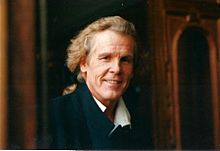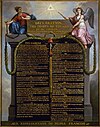
Thomas Jefferson was an American statesman, diplomat, lawyer, architect, philosopher, and Founding Father who served as the third president of the United States from 1801 to 1809. He was the primary author of the Declaration of Independence. Following the American Revolutionary War and prior to becoming president in 1801, Jefferson was the nation's first U.S. secretary of state under George Washington and then the nation's second vice president under John Adams.
Sarah "Sally" Hemings was an enslaved woman with one-quarter African ancestry owned by president of the United States Thomas Jefferson, one of many he inherited from his father-in-law, John Wayles.
Randolph Jefferson was the younger brother of Thomas Jefferson, the only male sibling to survive infancy. He was a planter and owner of the Snowden plantation that he inherited from his father. He served the local militia for about ten years, making captain of the local militia in 1794. He also served during the Revolutionary War.

Richard Cosway was a leading English portrait painter of the Georgian and Regency era, noted for his miniatures. He was a contemporary of John Smart, George Engleheart, William Wood, and Richard Crosse. He befriended fellow Freemason and Swedenborgians William Blake and Chevalier d'Éon. His wife was the Italian-born painter Maria Cosway, a close friend of Thomas Jefferson.

Martha "Patsy" Randolph was the eldest daughter of Thomas Jefferson, the third president of the United States, and his wife, Martha Wayles Skelton Jefferson. She was born at Monticello, near Charlottesville, Virginia.
Eston Hemings Jefferson was born into slavery at Monticello, the youngest son of Sally Hemings, a mixed-race enslaved woman. Most historians who have considered the question believe that his father was Thomas Jefferson, the third President of the United States. Evidence from a 1998 DNA test showed that a descendant of Eston matched the Jefferson male line, and historical evidence also supports the conclusion that Thomas Jefferson was probably Eston's father. Many historians believe that Jefferson and Sally Hemings had six children together, four of whom survived to adulthood. Other historians disagree.
The Jefferson–Hemings controversy is a historical debate over whether there was a sexual relationship between the widowed U.S. President Thomas Jefferson and his slave and sister-in-law, Sally Hemings, and whether he fathered some or all of her six recorded children. For more than 150 years, most historians denied rumors that he had a slave concubine, Sally Hemings. Based on his grandson's report, they said that one of his nephews had been the father of Hemings's children. In the 21st century, most historians agree that Jefferson is the father of one or more of Sally's children.

Thomas Jefferson is a 1997 two-part American documentary film directed and produced by Ken Burns. It covers the life and times of Thomas Jefferson, the 3rd President of the United States.

Madison Hemings was the son of the mixed-race enslaved woman Sally Hemings and, according to most Jefferson scholars, her enslaver, President Thomas Jefferson. He was the third of her four children to survive to adulthood. Born into slavery, according to partus sequitur ventrem, Hemings grew up on Jefferson's Monticello plantation, where his mother was also enslaved. After some light duties as a young boy, Hemings became a carpenter and fine woodwork apprentice at around age 14 and worked in the joiner's shop until he was about 21. He learned to play the violin and was able to earn money by growing cabbages. Jefferson died in 1826, after which Sally Hemings was "given her time" by Jefferson's surviving daughter Martha Jefferson Randolph.

The Golden Bowl is a 2000 period romantic drama film directed by James Ivory. The screenplay by Ruth Prawer Jhabvala is based on the 1904 novel of the same name by Henry James, who considered the work his masterpiece. It stars Kate Beckinsale, James Fox, Anjelica Huston, Nick Nolte, Jeremy Northam, Madeleine Potter, and Uma Thurman.

Heat and Dust is a 1983 British historical romantic drama film, with a screenplay by Ruth Prawer Jhabvala based on her novel, Heat and Dust (1975). It was directed by James Ivory and produced by Ismail Merchant. It stars Greta Scacchi, Shashi Kapoor and Julie Christie.

Thomas Jefferson Randolph of Albemarle County was a Virginia planter, soldier and politician who served multiple terms in the Virginia House of Delegates, as rector of the University of Virginia, and as a colonel in the Confederate Army during the American Civil War. The favorite grandson of President Thomas Jefferson, he helped manage Monticello near the end of his grandfather's life and was executor of his estate, and later also served in the Virginia Constitutional Convention of 1850 and at the Virginia Secession Convention of 1861.
Mary Jefferson Eppes, known as Polly in childhood and Maria as an adult, was the younger of Thomas Jefferson's two daughters with his wife who survived beyond the age of 3. She married a first cousin, John Wayles Eppes, and had three children with him. Only their son Francis W. Eppes survived childhood. Maria died months after childbirth.

Maria Luisa Caterina Cecilia Cosway was an Italian-English painter, musician, and educator. She worked in England, France, and later Italy, cultivating a large circle of friends and clients, mainly as an initiate of Swedish and French Illuminism and an enthusiastic revivalist of the Masonic Knights Templar.
James Hemings (1765–1801) was the first American to train as a chef in France. Three-quarters white in ancestry, he was born into slavery in Virginia in 1765. At eight years old, he was purchased by Thomas Jefferson at his residence of Monticello.
Elizabeth Hemings was an enslaved mixed-race woman in colonial Virginia. With her enslaver, planter John Wayles, she had six children, including Sally Hemings. These children were three-quarters white, and, following the condition of their mother, they were enslaved from birth; they were half-siblings to Wayles's daughter, Martha Jefferson. After Wayles died, the Hemings family and some 120 other enslaved people were inherited, along with 11,000 acres and £4,000 debt, as part of his estate by his daughter Martha and her husband Thomas Jefferson.
Thomas Jefferson, the third president of the United States, owned more than 600 slaves during his adult life. Jefferson freed two slaves while he lived, and five others were freed after his death, including two of his children from his relationship with his slave Sally Hemings. His other two children with Hemings were allowed to escape without pursuit. After his death, the rest of the slaves were sold to pay off his estate's debts.
Harriet Hemings was born into slavery at Monticello, the home of Thomas Jefferson, third President of the United States, in the first year of his presidency. Most historians believe her father was Jefferson, who is now believed to have fathered, with his slave Sally Hemings, four children who survived to adulthood.

Thomas Jefferson, the third president of the United States, was involved in politics from his early adult years. This article covers his early life and career, through his writing the Declaration of Independence, participation in the American Revolutionary War, serving as governor of Virginia, and election and service as Vice-President to President John Adams.
Edith Hern Fossett (1787–1854) was an African American chef who for much of her life was enslaved by Thomas Jefferson before being freed. Three generations of her family, the Herns, worked in Jefferson's fields, performed domestic and leadership duties, and made tools. Like Hern, they also took care of children. She cared for Harriet Hemings, the daughter of Sally Hemings, at Thomas Jefferson's Monticello plantation when she was a girl.












